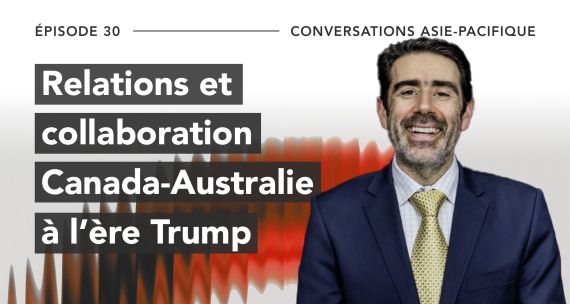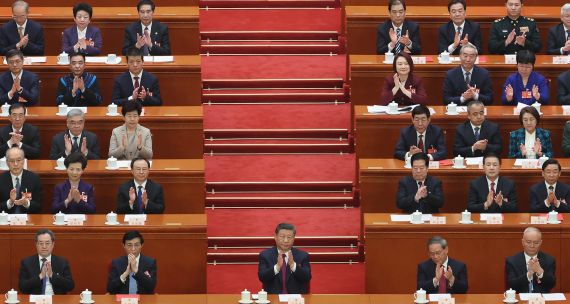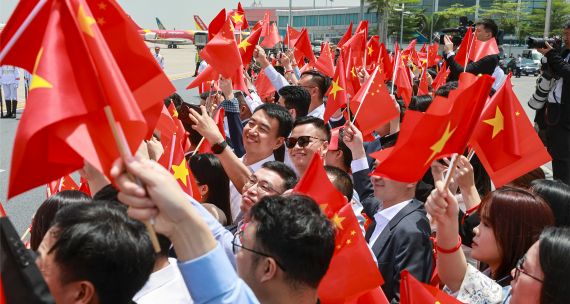Before U.S. President Donald Trump was elected, he campaigned on putting America first. His protectionist views have resonated with working-class Americans who believe increased free trade is eroding the U.S.’s once robust manufacturing industries.
After his first year in office, the U.S. president has begun to turn his mercantilist views into reality. Under the guise of strengthening the U.S. economy while preserving U.S. national security, he has issued a set of stringent policies vis-à-vis a new trade agenda. His newest punitive import tariffs on steel and aluminum, for example, follow prior import tariff increases on Canadian softwood lumber and Chinese and Korean solar panels and washing machines.
As the U.S. abandons its role as the champion of an open global trading order, a unique opportunity arises for the emerging and established economies in the Asia Pacific to fill the void.
The questions that now emerge are will Asian leaders reaffirm their commitment to pursuing increased free trade or could President Trump’s increasingly protectionist trade policies lead to a tit-for-tat global trade war across the Pacific? And, what will this mean for Canada, a country caught in the middle and whose largest trade partner is the U.S.?
In this Virtual Roundtable, the Asia Pacific Foundation of Canada brought these questions to a panel of trade experts, asking them to weigh in on President Trump’s ‘America First’ trade agenda and its implications for Canada and the global rules-based trading order. Here, in alphabetical order, are their responses.
Jonathan Berkshire Miller Responds:
Trump’s protectionist trade approach is continuing to serve against U.S. strategic interests in East Asia. This was initially felt most clearly with the Trump administration’s withdrawal from the Trans-Pacific Partnership in the first week after the president’s inauguration. Trump has now doubled-down on trade friction with his promise at the APEC Leaders’ Summit last year in Vietnam for “fair and reciprocal” trade agreements and his rhetorical vitriol towards multilateral deals. This transactional and coercive approach has eroded U.S. credibility in the region, most notably in Southeast Asia, and will make it increasingly challenging for Washington to pursue its political-security goals in the region – namely its new embrace of an “Indo-Pacific” strategy. It has also opened a door for China to – falsely – champion itself as a defender of liberal trade practices.
States in the region likely will bind together to express their opposition to such protectionism via the G7, G20 and other regional fora such as APEC and the East Asia Summit. The conclusion and signature of the Comprehensive and Progressive Trans-Pacific Partnership (CPTPP) – or TPP-11 – is a positive example of unity and commitment to strong regional trade practices. The issues have become more complicated though as the White House has launched unilateral tariffs on a number of states in the region – including its largest Asian ally, Japan. Tokyo will be incensed even more so noting that most other U.S. allies and partners – including Canada, Mexico, Australia, South Korea, and the European Union – have all received exemption from these draconian measures.
Canada meanwhile must continue to work closely with the rest of the G7 and other international partners to remain united in opposition to such moves. The tone and tenor of this opposition, however, needs to be carefully calibrated as Ottawa’s resources are limited and it is antithetical to Canada’s interests to engage in a drawn out trade war with Washington.
Stephen Nagy Responds:
Asian economies are historically export-based economies. This dependency has become more pronounced in the post-Global Financial Crisis (2008) era in which a trend toward anti-trade has gripped many Western countries. China has responded to this trend through the ‘Belt and Road Initiative’ (BRI), an effort to export over capacity, to open new trade markets, and a strategic initiative to decrease dependence on the U.S. and Western economies for growth.
Japan has taken a different approach, becoming the leader in expanding trade relations as evidenced through the TPP-11 (CPTPP) and the Japan-EU Economic Partnership Agreement. Southeast Asian countries such as Singapore, Malaysia, Brunei, and Vietnam have also come to the conclusion that blending intra-regional and extra-regional trade partners is the ideal way to weather trade uncertainty emanating from Washington. Others, such as South Korea, must pursue trade to sustain their export-based economies. Ultimately, we see a bifurcation of strategies to mitigate an increasingly protectionist trade agenda in the U.S. – the China approach, which focuses on developing countries and developing new markets through the BRI, and the “rest” that seek to participate in open intra- and inter-regional trade agreements that are a mixture of 21st century trade rules that leave the doors open for U.S. participation, even if that means renegotiation or modification of agreed-upon rules.
Canada’s largest trading partner is the U.S. by far. It is in a fortunate position compared to other countries in that NAFTA over the past 20 years has created synergistic comparative advantages that make dramatic revision of NAFTA or protectionist approaches to U.S.-Canada trade counterproductive at a macro level. At the same time, Washington’s increasingly protectionist policies may provide Canada the opportunity to open its markets to countries and regions that may be increasingly challenged by Washington’s efforts to put “America First.” The CPTPP is a good example of Canada stepping up to the trade plate. Canada should work with partners such as Japan to actively increase the CPTPP’s membership (South Korea would be a great candidate, but even Britain) while at the same time cultivating the conditions to welcome the U.S. back into the agreement once anti-trade sentiments or political alignments are more conducive.
Hugh Stephens Responds:
Although Chinese President Xi Jinping claimed the role of champion of the international trading system at his talk in Davos in 2017, (“We must promote trade and investment, liberalization and facilitation through opening up – and say no to protectionism.”) there is a serious risk that China will be tempted to retaliate against U.S. tariffs imposed as result of U.S. claims of intellectual property infringements by China. This is all the more likely if the U.S. proceeds unilaterally rather than through the World Trade Organization (WTO). The White House seems determined to take some form of punitive action against China, largely for domestic political reasons. The steel and aluminum tariffs were aimed at the wrong target and, while potentially provoking a retaliatory response from some trading partners, did not really engage China. Wide-ranging punitive trade action under the guise of IP, based on Section 301 of the US Trade Act of 1974, will be specifically targeted at China, and there is real potential for China to respond in kind.
Over the past year, since Xi’s Davos pronouncements, China has increasingly flexed its strategic and trade muscles, and continues to lay the foundation for its own version of international economic integration, centred on the ‘Belt and Road Initiative’ and the Asian Infrastructure Development Bank. It cannot be guaranteed that China will continue to be invested in the WTO in the event that the U.S. decides to bypass the international trading order that it helped to create. Unilateral action by the U.S. could be the tipping point for China to begin forging its own version of trading rules, (while still paying lip-service to the WTO system).
Other trading partners in the Asia Pacific will urge restraint on both China and the U.S. It is unlikely that Japan, Korea or ASEAN will resort to retaliatory tariffs, at least in the first wave of response, as they will cling to the hope that at the end of the day they may achieve exemptions. Domestic politics in all these countries will dictate, however, that governments cannot sit idly by while the U.S. takes unilateral trade action to erect protectionist barriers. The threat of retaliation is an established part of normal “negotiations” when WTO non-compliant trade actions are taken, and domestic politics demands that governments be seen to stand up to bullying.
The same is true in Canada, although Canada is in a particularly difficult situation when it comes to potential retaliation owing to the large number of bound tariff lines and a limited range of options to exercise retaliation. Canada is also aware that retaliation may harm the Canadian economy more than its potential target, the U.S., given its much higher dependency on bilateral Canada-U.S. trade. While Canada can fashion its retaliation to hurt some sensitive U.S. sectors, Canadian retaliation overall will have little impact on the U.S., especially over the short term. In the long term, Canada would likely have to negotiate a removal of any retaliatory barriers.
Given this situation, Canada has limited options. And while examining its options for retaliation, will deploy its efforts, in the first instance, to try to convince the Trump Administration that punitive protectionist trade actions will damage U.S. interests and, if this approach fails, to seek exemptions for Canada on the basis of the integrated North American economy. At the same time, Canada will work actively with those governments in the Asia Pacific whose interests coincide with those of Canada, notably Japan, Korea, Australia, New Zealand, and ASEAN, to turn back U.S. protectionism before it reaches the stage of tit-for-tat retaliation.
We are potentially approaching a critical inflection point for the international trade order. Let’s hope that cooler heads prevail other than those currently driving trade policy in the White House.
Yves Tiberghien Responds:
Just as the shock of the steel and aluminium tariffs was being gradually absorbed, U.S. actions took a turn for the worse on March 22. On that day alone, President Trump unleashed a much greater trade battle with China, under Section 301 of U.S. trade law, instructing the Office of the United States Trade Representative (USTR) to come up with across-the-board tariffs on up to 1,300 products for a total amount of US$50 billion, or nearly 10% of U.S.-China trade totals. This triggered a very stern response from Chinese Ambassador Cui Tiankai who bluntly warned the U.S., "If somebody tries to impose a trade war on us . . . we will certainly fight back and retaliate. If people want to play tough, we will play tough with them and see who will last longer.” China followed with a first round of announced tariffs totalling US$3 billion, a small warning volley. On the same day, President Trump targeted Japan, the one ally that ended up not being exempted from the earlier steel tariffs, specifically stating on Twitter: “I’ll talk to Prime Minister Abe of Japan, and others. Great guy – friend of mine, and there'll be a little smile on their face, and the smile is, ‘I can't believe we've been able to take advantage of the United States for so long.’ So those days are over.” This shot was not expected, and informed sources indicate that this is a crass and direct attempt by the Trump administration to force Japan into a bilateral trade negotiation that Japan does not want. Capping that same day, President Trump sacked General H.R. McMaster as National Security Adviser and replaced him with the notorious hawk, John Bolton.
Clearly, Trump is now unleashing a series of very tough unilateral trade actions that leave no partner untouched. In some cases, Trump has threatened to tear down regional agreements (NAFTA, but also KORUS, and of course the TPP) or to ignore the World Trade Organization (WTO) altogether. Combined, the level and breadth of the trade sanctions and attacks unleashed by the Trump administration this month is the most serious threat to the global trading system since its expansion in the early 1990s, and possibly since the Second World War. Robert Lighthizer, the current U.S. Trade Representative, has hinted several times that he would not mind pulling the U.S. out of the WTO altogether if it became an obstacle to U.S. goals. Worse, this new round of U.S. sanctions will not solve the regional and social crises that have hit the U.S. Midwest or the Appalachians. In fact, they will only create uncertainty, lower growth, and cannot on their own trigger a revival of manufacturing against forces of technology and global economics. The tax policies pursued by Trump reduce the capacity of the government to support losers of globalization through infrastructure, trade adjustment assistance, or education, and will make inequality even worse.
In this context, China will be compelled to initially respond through sanctions of its own and to also accelerate the negotiation of exclusionary trade agreements with third countries, in the same way that Canada struck a preferred deal with the U.K. in response to the protectionist U.S. Smoot-Hawley Tariff Act of 1930. However, China is also aware that the U.S. Section 301 case targeting IP violations, cyber-hacking, and the spillover effects of China’s modern industrial policy, enjoys broad support from industry in the U.S. and in fact from other countries that have also felt victimized. China is also aware that its rise is only halfway through, and that it needs a stable economic environment to continue its long-term dream of modernization. After the initial bluster, China may choose to compromise and offer reforms and adjustments that will have a significant effect on these issues. The problem of course is that the U.S. administration is currently too disorganized to develop a sustained process of negotiations with China.
Other Asian countries, specifically Japan and Korea, will not engage in tit-for-tat responses to the Trump threats. They are more likely to seek accommodation, delay, or deflection. In sum, while U.S. actions are incredibly destabilizing in content and in process, the system still has enough resilience and enough countries dedicated to a global trading system that it may cushion the blows for now. The critical variable is the U.S.- China relation, upon which the system ultimately depends.
Canada is clearly buffeted by this new U.S.-China whirlwind. Most recent developments indicate that Robert Lighthizer may indeed be taking a more accommodating view toward NAFTA, just as he unleashes the higher-stakes battle with China (and Japan and others). At one level, the USTR cannot afford to wage a trade war on every front. And it is now clear that many members of Congress as well as U.S. governors have stood up to indicate that a NAFTA implosion would have a costly impact on many states and would adversely affect the mid-term elections in the fall. This proves that the strategy pursued by Minister of Foreign Affairs Chrystia Freeland and the Canadian government was ultimately right: engage states and business groups all across the U.S. and box in the USTR from the bottom up.
Additionally, any Chinese trade sanctions on U.S. agriculture exports will open up more space (and possibly higher prices) for Canadian farmers. On the other hand, Canada will have to guard against a possible surge of Chinese and other exports looking for new markets, which would force Canada to take safeguard measures.
In the bigger picture, China is highly dependent on the global trading system and global economy. But if the U.S.-China trade war gets out of hand, or if the U.S. stubbornly triggers a tit-for-tat sanction game with some aspects of the 1930s, Canada will not be able to escape the global uncertainty and risks.







